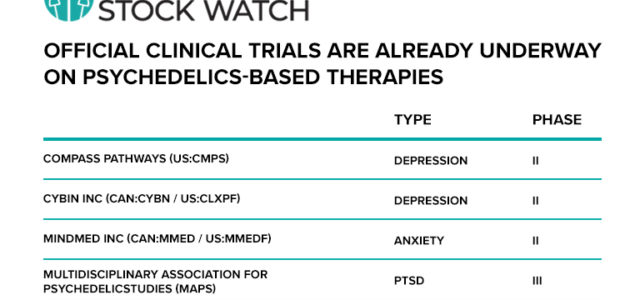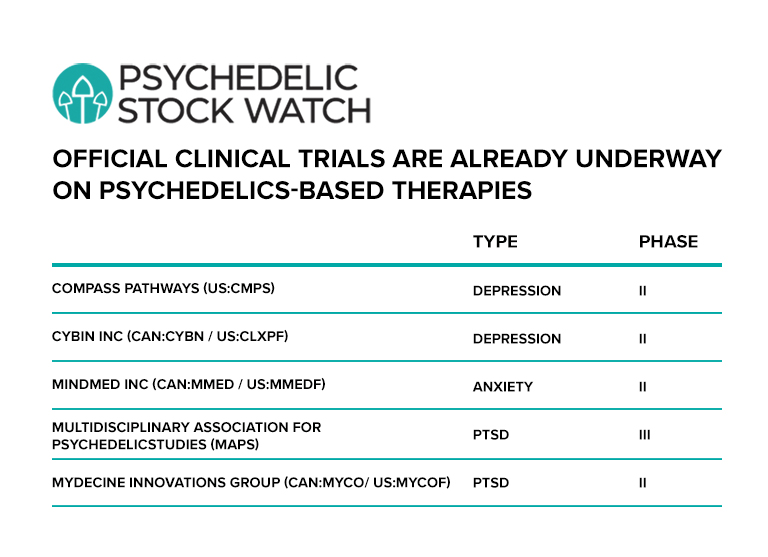The Mental Health Crisis: A Pandemic Becomes A Catastrophe
Marijuana Stocks, Finance, & InvestingUncategorized April 9, 2021 MJ Shareholders

- Over 1 billion people were afflicted by stress-related disorders like depression, anxiety, addiction and PTSD before the COVOD-19 pandemic struck
- COVID-related fears and oppressive government lockdowns have caused rates of depression, anxiety and substance abuse to skyrocket
- Psychedelic drugs are the only hope in addressing this rapidly worsening crisis
The Mental Health Crisis.
It’s slowly penetrating public awareness. But considering the scope of this socio-economic catastrophe, it doesn’t get nearly enough attention from government, the media, or even or our healthcare system.
This Crisis is (by far) the largest single health issue on the planet today. Not only does it impact vast numbers of people, it has a profound impact on our economies – in several different ways.
The Mental Health Pandemic
The numbers are staggering.
Prior to the outbreak of the COVID-19 pandemic, over 1 billion people were afflicted with stress-related disorders like depression, addiction, anxiety and PTSD. Approximately 1 in 6 people on the planet.
To put this into perspective, for every person who has been infected with COVID-19 globally (including the 80+% already cured), there are 10 people suffering from these stress-related disorders. And that was before the coronavirus pandemic itself (and oppressive government lockdowns) caused these numbers to spike higher.
How much worse has this mental health pandemic gotten since the coronavirus pandemic began?
Depression/anxiety
- Overall, the percentage of Americans suffering from depression had already more-than-tripled by September 2020, from 8.5% to 27.8% (91.75 million Americans) [source: Boston University]
- Rates of “moderately severe depression” among Americans have quadrupled (from 2% to 8%) and rates of “severe depression” have more than quintupled (from less than 1% to 5%) [source: WebMD]
- The depression/anxiety pandemic continues to worsen: between August 2020 and January 2021, the percentage of Americans experiencing anxiety or depression jumped from 36% to 42% [source: CDC]
Substance abuse
- As of August 2020, sales of alcohol in the U.S. had risen by 27%, along with a 32% increase in non-prescribed fentanyl, 20% increase in methamphetamines, 12.5% increase in heroin, and 10% increase in cocaine, leading to an 18% increase in drug overdoses [source: EHS Today]
- By June 2020 (only 3 months after the start of the pandemic in the U.S.), more than 1 in 8 Americans (13%) had either started or increased their use of recreational drugs due to COVID-related stress [source: CDC]
- By June 2020, U.S. drug overdose deaths had reached their highest level ever, 81,000 overdose deaths from June 2019 to June 2020 [source: Statnews]
If this isn’t dire enough already, new numbers indicate that those who contract COVID-19 have a greatly elevated risk of mental health disorders.
Compare this with the COVID-19 pandemic itself. According to the latest numbers from the CDC, less than 10% of the U.S. population has contracted COVID-19 (30.6 million), with the vast majority of those people cured.
While both governments and media obsess about vaccines for the COVID-19 pandemic (in the U.S. and abroad), the much larger mental health pandemic has been largely ignored by the media – and completely neglected by governments.
Yet in addition to the tremendous human toll from the Mental Health Crisis, it also produces huge economic costs.
The tremendous economic costs of the mental health pandemic
As with the horrific numbers of people with mental health disorders, the economic costs associated with the Mental Health Crisis were already gigantic prior to the start COVID-19 pandemic.
All those numbers were pre-COVID.
With depression rates tripling in the U.S., anxiety steadily rising, and substance abuse soaring, we can expect the economic costs associated with the mental health pandemic to be rising at a commensurate rate.
Trillions of dollars lost per year globally due to decreased productivity. An epidemic of people disabled by mental health-related problems. Over $1 trillion in economic costs from substance abuse per year – in the U.S. alone.
How did this problem ever become a “Crisis” – and now a pandemic?
The failure of conventional medicine to treat mental health disorders
Twenty-first century healthcare has utterly failed in providing even adequate treatment standards for these mental health disorders. This litany of failure can be documented in numerous ways.
“First-line drugs” to treat depression (antidepressants) don’t work for about 50% of patients. Of those who do obtain some relief, one-third of that is merely a Placebo Effect. Not only are these drugs ineffective, they are addictive and actually induce suicidal thoughts in a significant percentage of those using these drugs.
Due to the abysmal treatment options, two-thirds of Americans exhibiting symptoms of depression don’t even seek treatment.
The numbers are equally dismal with respect to the treatment of post-traumatic stress disorder in the U.S. (PTSD). Officially, 8 million Americans are known to suffer from PTSD, but some estimates put that total as high as 24 million.
Most of the PTSD sufferers in the U.S. are veterans, a legacy of the numerous wars initiated by the United States in recent decades. Two-thirds of the veterans being treated for PTSD by the Department of Veterans Affairs report no benefit from their treatment.
Then there is substance abuse. Addiction “therapy” in the U.S. is, at best, a revolving door and, at worst, just a bad joke. How bad is the joke?
Tobacco companies actually invest in “tobacco cessation” products because the treatments have such low success rates. They make huge profits addicting Americans to (and killing them from) nicotine. And then more profits as these nicotine addicts try – and fail – to rid themselves of this addiction. Easy money.
Overall, $35 billion per year is spent (wasted?) in the U.S. each year on various forms of revolving-door drug rehabilitation. The four “R’s”: rehab, release, relapse, repeat.
It’s a cycle of failure and often despair because the medical profession lacks effective drugs to control addictive cravings. Yet despite this massive pharmaceutical failure, Big Pharma has largely walked away from drug development for mental health disorders.
By 2016, the Guardian was reporting that multinational pharmaceutical companies had slashed mental health R&D by 70%. A cynic might suggest that these drug companies don’t want to see a cure for drug addiction.
A crisis becomes a pandemic – and now a catastrophe
(At least) ten people suffer from mental health disorders for every person infected with (and cured of) COVID-19. While oppressive government lockdowns have made dubious progress in fighting the COVID-19 pandemic, they have been extraordinarily effective in worsening the mental health pandemic.
How much more of “fighting COVID” and ignoring the Mental Health Crisis can our societies endure?
We don’t have precise numbers on the scope of the mental health pandemic today. But with (a) the huge percentages now afflicted and (b) the speed at which these mental health disorders are worsening, a ballpark estimate is that the overall number of sufferers has increased by ~50%.
This would mean that roughly 1 in 4 people on the planet (25%) are now grappling with either depression, anxiety, addiction, or PTSD. And those aren’t the only categories of mental health rapidly worsening since the beginning of COVID.
Among the elderly, rates of dementia are skyrocketing due to the isolation and despair brought on by COVID lockdowns. There were 42,000 additional deaths from dementia (due to COVID) in 2020 alone.
The COVID-19 pandemic would/will eventually run its course – even if our governments did nothing. But the 1.5 to 2 billion people now suffering from some form of mental health disorder need treatment. Few people can correct mental health disorders on their own.
At some point, all these mental health illnesses and deaths and disability and lost productivity will simply become too much for our societies and economies to bear.
That should be just a new twist on an old joke. Instead, it is the trajectory along which most Western societies are now headed.
We can debate how effective governments have been in dealing with the COVID-19 pandemic. But there can be no debate about how (in)effective governments have been in coping with the mental health pandemic.
Absolute failure. Gross negligence.
Psychedelic drugs: the only hope for better mental health
This is not a matter of our governments being unable to address the Mental Health Crisis. Because there is something they could/should be doing. They are simply asleep at the wheel as the mental health pandemic rages.
Psychedelic drug development represents a real solution for sufferers of these mental health disorders.

Multiple trials on psychedelics-based therapies for substance abuse are in their early stages.
As Psychedelic Stock Watch has illustrated on many occasions, these drugs have been generating spectacular results in both clinical and non-clinical settings.
For 50 years, psychedelic drugs were criminalized via the insanity of War on Drugs drug prohibition. That’s a half-century that Big Pharma had to come up with adequate alternative drugs to address mental health problems. And multinational drug companies failed completely.
That’s a very strong argument that psychedelic drugs are not merely the best hope to address the Mental Health Crisis. They are literally the only hope.
Decades of neglect by governments in addressing mental health issues has created a catastrophe where billions of people are now in need of treatment.
There are two pandemics raging across the planet today. The smaller one (by far) is the coronavirus pandemic. It is long past time for our governments to tackle the larger pandemic.
The Mental Health Crisis.
MJ Shareholders
MJShareholders.com is the largest dedicated financial network and leading corporate communications firm serving the legal cannabis industry. Our network aims to connect public marijuana companies with these focused cannabis audiences across the US and Canada that are critical for growth: Short and long term cannabis investors Active funding sources Mainstream media Business leaders Cannabis consumers









